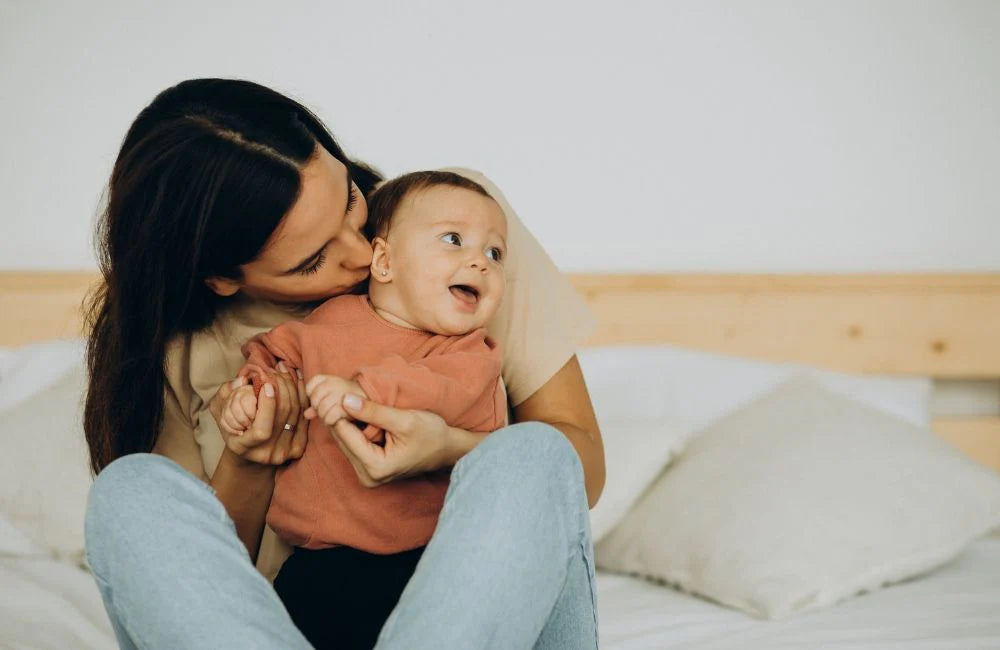
17 Engaging Activities with Babies That Will Help You Bond
Share
You’ve just met someone new. You’re so excited. You’re over the moon. Chances are that “someone new” is now your favorite person in the whole wide world.
It doesn’t matter if they’ve got nothing to say. You can just stare at them all day long and have the time of your life. At some point, though, you wish to start doing things together - spend some quality time and bond.
But, here’s the catch - your new acquaintance needs time to adapt and take in their surroundings (we’re talking about your newborn if it wasn’t clear up to this point). Depending on your baby’s developmental stage, there’s a lot of stuff you can do together.
Playing together creates a connection between you two and makes your baby feel secure and loved. They might not be able to say it, but they feel it and are not afraid to show it.
Here are some activities you can include in your daily routine to help your baby develop and create a strong bond with you.

Language and Communication Development Activities
1. Baby Talk
Baby talk can look and sound silly, but it's immensely beneficial. Speaking slowly, repeating words, exaggerating facial expressions, and using a higher pitch while talking occupies the baby’s attention and helps them develop their own language abilities.
2. Show your baby pictures and describe them
Use an old photo album or a children’s book with illustrations. Try avoiding phone or tablet screens for as long as possible. Point to each image and explain it to your child. They will understand a thing or two, don’t you worry. You’ll see them pointing their little fingers at the very same image you already explained the next time you show it to them.
3. Sing nursery rhymes
...or any other songs you like, for that matter. It’s important that you sing them because your baby loves your voice. It soothes them. It also trains your baby’s hearing and listening skills. Singing a song over and over will make your baby remember it and bring a smile to their face every time you start it from the top.
4. Read to your baby
Reading to your baby before bedtime will do wonders. It’s a great cuddle time, your baby will find comfort in your voice, and you two will create a bedtime routine. Unknowingly, your little one will get used to books being a cue for sleepy time.

Sensory and Physical Development Activities
5. Object tracking
This is not just a fun baby activity, it’s also an excellent exercise for eye movement and sight development. Your baby’s sight is not yet fully developed, and this sort of play will encourage your little one to practice moving their eyes as a team and improve their focus. Simply take an item they like, most likely a toy, and slowly move it within their sight range.
Read more about infant vision from birth to 24 months.
6. Tummy time
You can lay your baby on the blanket on the floor, on the bed, and even on your chest. Try calling your baby from different sides to encourage them to move their head around and wiggle left and right. This way, your baby strengthens their neck, shoulders, and arms.
Also, they work on sound perception, trying to figure out the origin of different sounds. When you first start with tummy time, keep it to 2 or 3 sessions a day. Each session shouldn’t last longer than 3-5 minutes. As your baby gets older, you should increase it by a little.
7. Puppet play
A toy like Montessori Baby Soft book (don’t let the name fool you) can be a great introduction to playing with puppets. Stick your hand in it, do funny voices, move it around, and share a laugh with your baby. Most babies we meet find puppets really funny for some reason.
8. Blow and poke bubbles
You can do it in the bath, in your living room, outdoors, or wherever you like. This is one of those activities with babies that sometimes leave some mess behind, but it’s great for their hand-eye coordination and dexterity. Just be careful so the soap doesn’t end up hurting someone’s eyes.
9. Play with rattle toys
For generations, babies have played with rattles. There’s a good reason for it - they enjoy the sound of it. We might think it’s too loud, but they just love it. Rattles are great for grasping and motor skills and also teach cause and effect.
These toys might be the first to teach infants that their actions have an impact on their environment. A baby learns that it’s them who’s shaking the rattle and, consequently, making the sound.
10. Play with a permanence box
Once your baby can sit on their own, it's a good time to introduce a toy called Montessori Object Permanence Box It's one of those Montessori toys for babies designed to explain to the youngest one how things still exist even when they can't see them.
At that age, they are still in the phase of understanding and are genuinely surprised when they see something disappear and appear again. Furthermore, a ball that comes with this toy is good for training a baby's finger and hand muscles, as well as fine motor skills.
11. Bath time playtime
Some babies don’t like water. It might scare them or doesn’t feel comfortable. Some babies have a really strong opinion on the subject of shampoo going anywhere near their faces. That’s why you can do some fun stuff while washing your baby.
Play some music, use some rubber ducks to keep them entertained, and talk to them, and sooner rather than later, these little sessions will become your and your baby’s favorite time of the day.
12. Listen to some music
Music has an incredible effect on babies while they're not even born. The significance only rises the older they get. It helps babies fall asleep and develops their young brains. It also helps with learning new words and training memory. One of the first songs, or rather classical pieces, your child will probably listen to is Brahms’ Lullaby, and we wholeheartedly recommend it.
Read more about how music affects your baby's brain.

Social and Emotional Development Activities
13. Peek-a-boo
Your newborn loves your face, so any activity allowing them to see it is their favorite. However, when babies start to laugh at around 3 or 4 months, this is where the fun begins. Every time you hide and show your face, you’ll see your little one giggling. Peekaboo is also an excellent maneuvering trick when changing diapers.
14. Hide and seek and Hidden Objects
Once your baby can move on their own, whether it’s crawling or walking, you can start hiding stuff around them and asking them to find it. It’s a thrilling experience for babies. Once they get a little older, start playing hide and seek properly. These games help children develop their balance, agility, and problem-solving skills. However, always think about safety and your baby’s surroundings when goofing around.
15. Imitation game
Repeat your baby’s gestures and see if they will repeat yours. This is a great introduction to conversing since you’re doing it back and forth. Your baby will get a sense of what’s to come once they start saying their first words. Language is not only about knowing words and grammar but also about being aware of its social aspect.
16. Tickle tickle
Lay your baby on the back and tickle them softly. This is a wonderful bonding experience. However, be mindful of their reaction and stop if your baby doesn’t find it funny anymore. Once again, a great distraction when changing diapers.
17. Make funny faces
Place your baby in front of you and pull all sorts of silly faces. The sillier, the better - not only does it entertain your child, but it also helps them learn about other people’s expressions of happiness, sadness, or surprise, for example.
That first year or so with your baby is a beautiful experience. Yes, there’ll be some sleepless nights, but a few years from now, you’ll only remember the good times. The more stuff you two together, the stronger bond you will create for the future. Try some of our suggestions for activities with babies, and let us know how they worked out at info@karolinakids.com.
